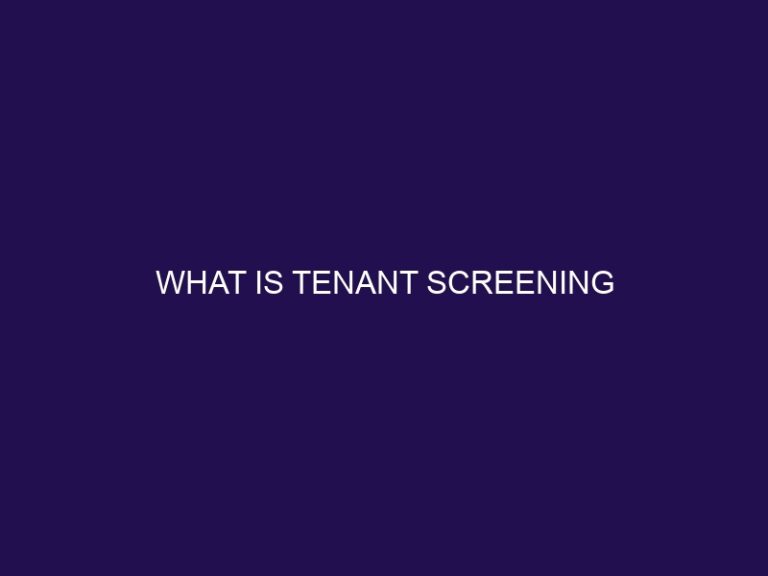What is a Pet Deposit
Understanding the concept of a pet deposit is essential for both tenants and landlords.
A pet deposit is a specific amount of money required by landlords from tenants who have pets.
This deposit serves as a form of security for potential damages or disruptions caused by the pets during the tenancy period.
It is important to comprehend the purpose and workings of a pet deposit to ensure a smooth renting experience for both parties involved.
By exploring key aspects such as the reasons landlords require pet deposits, what a pet deposit covers, how it functions, and important considerations for pet owners, individuals can navigate pet-related lease terms more effectively. Understanding pet-related lease terms and potential consequences of violating them is crucial knowledge for both tenants and landlords.
What is a Pet Deposit?
A pet deposit, also known as a security deposit, is a monetary requirement imposed by landlords or property owners for tenants who have pets in their rental unit. This deposit is specifically designed to cover any potential damages caused by the pet throughout the duration of the tenancy. The amount of the pet deposit can vary depending on the individual landlord and the property being rented. It is crucial for pet owners to thoroughly understand the terms and conditions associated with this deposit to ensure their compliance and to ensure their beloved pet is welcomed in the rental unit.
Interestingly, a study conducted by the American Veterinary Medical Association revealed that approximately 68% of households in the United States have at least one pet.
Understanding the Purpose of a Pet Deposit
Understanding the Purpose of a Pet Deposit
When renting a property with a pet, it is important to understand the purpose of a pet deposit. Landlords often require a pet deposit to protect themselves from any damages that may occur during the tenancy. This deposit serves as a form of financial coverage for the landlord. The pet deposit is typically refundable, as long as there are no damages caused by the pet.
To explain the purpose of a pet deposit further, here is a breakdown in a table format:
| Purpose | Explanation |
|---|---|
| Protection | Ensures the landlord is financially covered for pet damages |
| Accountability | Encourages responsible pet ownership and behavior |
| Compensation | Covers the costs of repairing any pet-related damages |
For tenants, it is important to follow these suggestions regarding the pet deposit:
- Understand the terms: Familiarize yourself with the pet deposit policy to avoid any surprises.
- Maintain the property: Take proper care of the rental unit and prevent any pet-related damages.
- Communicate openly: Keep your landlord informed about your pet’s behavior and any concerns.
By understanding the purpose of a pet deposit, both tenants and landlords can address any potential issues that may arise from having a pet in a rental property fairly.
Why Do Landlords Require Pet Deposits?
Why Do Landlords Require Pet Deposits?
Landlords often require pet deposits for several reasons. One of the main reasons is that pets can cause damage to the property, such as scratches, stains, or odors. Additionally, they may disturb other tenants due to excessive noise or allergies. As a result, pet deposits act as a form of insurance for landlords. It provides them with the necessary funds to cover any potential damages caused by pets.
By mandating a pet deposit, landlords can also ensure that tenants are held responsible for any expenses related to their pets. This helps landlords protect their property and reduce the financial burden associated with pet-related damages. Ultimately, requiring a pet deposit allows landlords to effectively mitigate the risks involved in allowing pets in their rental units.
What Does a Pet Deposit Cover?
What Does a Pet Deposit Cover?
A pet deposit covers any potential damages caused by a pet during a tenant’s occupancy. It helps ensure that landlords are compensated for any repairs or cleaning necessary once the tenant moves out. Here is a list of what a pet deposit typically covers:
|
Remember, the specific coverage and refund policies may vary depending on the landlord or property management company.
Fun Fact: Did you know that some landlords may also require additional pet rent or fees in addition to the pet deposit?
How Does a Pet Deposit Work?
- When considering renting a property, it is essential to inquire about the pet policy and if a pet deposit is required, ensuring a secure financial safety net for any possible harm caused by pets.
- Prior to finalizing the rental agreement, make sure to communicate with the landlord or property management to obtain information about the pet deposit amount and any additional terms or conditions.
- Before moving into the rented accommodation, be prepared to pay the pet deposit in addition to the regular security deposit.
- To ensure the full refund of the pet deposit, it is crucial to comply with all pet-related rules and regulations throughout the tenancy, thus avoiding any potential deductions.
- Upon vacating the premises, the landlord will evaluate the property for any pet-related damages, and if none are found, the pet deposit will be returned in its entirety.
How Much is Typically Required for a Pet Deposit?
How Much is Typically Required for a Pet Deposit? The amount required for a pet deposit can vary depending on various factors, such as the landlord’s policies, location, and type of pet.
- Location: In some areas, pet deposits may be regulated by local laws and regulations.
- Type of Pet: Landlords may charge higher deposits for pets that are larger or more prone to causing damage.
- Landlord’s Policies: Each landlord may have their own policies regarding pet deposits, with some charging a set fee and others basing it on a percentage of the rent.
While there is no standard amount for a pet deposit, it is common for the deposit to range from $100 to $500 or more.
Is the Pet Deposit Refundable?
A pet deposit is a refundable amount of money paid by tenants to landlords when they have pets in a rental property. Whether or not the pet deposit is refundable depends on certain factors. Here are some important points to consider about the refundability of a pet deposit:
- Terms and Conditions: The refundability of a pet deposit is typically outlined in the lease agreement. It is important for tenants to carefully review the terms and conditions of the lease to understand if the deposit will be returned.
- Damage Assessment: Landlords may retain a portion or the entire pet deposit if there are damages caused by the pet. This could include things like scratches on floors or furniture, stains, or excessive shedding.
- Cleaning and Repairs: If the pet has caused any damage beyond regular wear and tear, the landlord may use the pet deposit to cover the cost of cleaning or repairs necessary to restore the rental property to its original condition.
- Documentation: Tenants should document the condition of the rental property and any existing damages before moving in with their pet. This can help to ensure a fair assessment of any potential damage and increase the chances of a full or partial refund.
- Communication: It is important for tenants to communicate with their landlord about any potential issues or concerns regarding the refund of the pet deposit. Open dialogue can help resolve any misunderstandings and ensure a smooth process.
Can a Landlord Use the Pet Deposit for Damages?
A landlord can use the pet deposit for damages caused by the tenant’s pet. In this case, the pet deposit serves as a protection for the landlord in case there are any damages to the rental property. So, the answer to the question “Can a Landlord Use the Pet Deposit for Damages?” is yes. If the pet causes any scratches, stains, or other types of damage, the landlord can deduct the cost of repairs from the pet deposit. It is crucial for the landlord to provide an itemized list of damages and the corresponding costs. However, if there are no damages, the landlord must return the full pet deposit to the tenant.
Important Considerations for Pet Owners
As pet owners, it is crucial to take into account several important considerations to ensure the well-being of our beloved pets and maintain a harmonious living environment. Here are some essential factors to keep in mind:
- Living Arrangements: It is vital to confirm whether your rental property permits pets and understand any restrictions or additional fees that may apply.
- Pet-Friendly Amenities: Another crucial aspect is to search for nearby parks, walking trails, and pet-friendly establishments. This ensures that your pet’s exercise and socialization needs are adequately met.
- Veterinary Care: Taking care of your pet’s health is of utmost importance. Conduct thorough research to find local veterinarians, emergency clinics, and pet insurance options to provide essential healthcare services for your furry companion.
- Pet Safety: Ensuring the safety of your pet is vital. Take necessary measures to pet-proof your home, such as securing electrical cords and using childproof locks. It is also crucial to keep toxic substances out of their reach.
In 1963, the renowned Bob Barker became the host of “The Price Is Right” and concluded each episode with a powerful reminder to “have your pets spayed or neutered.” This catchphrase has become famous and serves as a valuable reminder of the significance of responsible pet ownership.
What Steps Should Pet Owners Take to Protect Their Deposit?
What Steps Should Pet Owners Take to Protect Their Deposit?
To ensure the safety of their pet deposit, pet owners should naturally incorporate the following steps:
- Prior to moving in, it is vital for pet owners to thoroughly document the condition of the rental unit. This includes noting any existing damages or stains that may already be present.
- In case of disputes, pet owners should take photographs or videos of the rental unit. These visual cues will serve as concrete evidence to support their claims.
- Pet owners must adhere to all pet-related lease terms, including requirements such as leash restrictions or noise limitations.
- Regular cleaning and proactive maintenance of the rental unit is crucial for preventing any damage or excessive wear and tear caused by the pet.
- In the event that the pet causes any damages, it is important for pet owners to promptly arrange for repairs. Calling a professional service provider will help minimize costs.
- Effective communication with the landlord or property manager is essential. Pet owners should address any concerns or issues related to their pet openly and honestly.
By diligently following these steps, pet owners can significantly reduce the possibility of losing their deposit. Furthermore, they will be able to maintain a harmonious and positive relationship with their landlord or property manager.
Are There Any Alternative Options to Pet Deposits?
Are There Any Alternative Options to Pet Deposits?
-
Pet Rent: There are alternative options available to pet deposits that can benefit both landlords and pet owners. Instead of a deposit, landlords can charge a monthly pet rent. This allows for a steady stream of income to cover any potential damages.
-
Pet Insurance: There are alternative options available to pet deposits that can benefit both landlords and pet owners. Requiring tenants to provide proof of pet insurance can offer assurance to landlords. This can help cover any damages or incidents caused by the pet.
-
Pet Guarantees or Higher Security Deposit: There are alternative options available to pet deposits that can benefit both landlords and pet owners. Landlords can increase the security deposit amount for tenants with pets to cover any potential damages.
By considering these alternative options, both landlords and pet owners can find a solution that works best for everyone involved.
Understanding Pet-Related Lease Terms
Understanding Pet-Related Lease Terms is crucial when considering a pet-friendly lease agreement. To avoid any surprises or misunderstandings, it is important to familiarize yourself with the following key aspects:
- Pet deposit: This refers to a refundable amount that is paid upfront to cover any potential damages caused by your pet.
- Pet rent: In exchange for allowing pets on the property, an additional monthly fee, known as pet rent, is required.
- Pet policies: Familiarize yourself with the rules pertaining to pet size, breed restrictions, noise limitations, and leash requirements.
- Pet liability: As a pet owner, it is essential to understand your responsibilities and any potential liability for injuries or damages caused by your pet.
By understanding these pet-related lease terms, you can ensure a smooth and mutually beneficial agreement with your landlord.
Can a Landlord Impose Restrictions on Pet Ownership?
A landlord has the right to impose restrictions on pet ownership in rental properties. These restrictions are put in place to protect the property and ensure the comfort and safety of all tenants. Common pet restrictions include limitations on the number of pets, size or breed restrictions, and additional fees or deposits. Landlords may also establish rules regarding pet behavior, such as noise control or requiring pets to be leashed in common areas. It is essential for pet owners to carefully review and abide by these restrictions to maintain a positive rental experience for everyone involved.
In a similar vein, can a landlord impose restrictions on pet ownership? In the early 1990s, many landlords imposed strict bans on pet ownership in rental properties due to concerns about property damage and noise complaints from other tenants. As attitudes towards pets changed and more studies highlighted the benefits of pet ownership, some landlords began to loosen these restrictions. Today, many rental properties explicitly allow pets, although certain restrictions may still apply depending on the property and the landlord’s policies. This shift reflects a growing understanding of the importance of pets in people’s lives and the benefits they can provide to their owners.
What are Some Common Pet Restrictions?
What are Some Common Pet Restrictions?
Landlords commonly impose several pet restrictions, including breed restrictions, weight restrictions, and limitations on the number of pets allowed. These restrictions serve various purposes. Breed restrictions, for example, are often put in place due to insurance policies or local regulations that designate certain breeds as potentially dangerous. Weight restrictions are commonly implemented to protect the floors and structural elements of the property from potential damage. Additionally, the number of pets allowed may be limited based on the property’s size or concerns about noise and hygiene. As responsible pet owners, it is crucial to carefully review and understand these restrictions before signing a lease agreement. By doing so, you can ensure compliance with the rules and prevent any potential issues that may arise.
Pro-tip: To avoid any misunderstandings or discomfort, pet owners should seek clarification regarding any pet restrictions and make sure they are comfortable with the limitations before signing the lease.
What Are the Consequences of Violating Pet-Related Lease Terms?
What Are the Consequences of Violating Pet-Related Lease Terms?
Infringing upon pet-related lease terms can result in several consequences for tenants. These consequences can vary depending on the specific terms stated in the lease agreement. Some potential outcomes include:
- Financial penalties: Tenants may be obligated to pay fines or fees for breaching pet-related lease terms.
- Eviction: Landlords possess the right to evict tenants who violate lease terms, including those that pertain to pets.
- Damage charges: If pets cause any harm to the rented property, tenants may bear responsibility and be required to cover the costs of repairs.
- Legal action: Landlords have the option to take legal actions against tenants who repeatedly violate pet-related lease terms. This may involve pursuing additional damages or seeking the termination of the lease agreement.
To avoid these consequences, it is crucial for tenants to carefully peruse and comprehend the pet-related lease terms, and consistently adhere to them throughout the entire duration of the lease.
Frequently Asked Questions
What is a Pet Deposit?
A pet deposit is an up-front payment made by renters to cover potential damages caused by pets in a rental property. It is similar to a refundable tenant security deposit but specifically designated to cover pet-related damages.
Are there any legal restrictions on pet deposits?
Yes, there may be legal restrictions on pet deposits. Some states limit the total security deposit amount, while others allow an additional pet-specific deposit. It is important for landlords to ensure their deposit amount is competitive and allowed by local laws.
Can landlords charge extra rent for service or emotional support animals?
No, fair housing laws may prohibit charging extra rent for service or emotional support animals. These animals are considered companion or assistance animals and are protected under laws.
What are the advantages of pet fees?
Advantages of pet fees include immediate income for landlords and fewer legal restrictions compared to pet deposits. Pet fees are a nonrefundable amount collected to cover potential pet-related damages.
Can landlords restrict the types and sizes of pets allowed?
Yes, landlords generally have the right to restrict the types, number, and sizes of pets allowed in their rental properties. However, there may be exceptions for service or companion animals protected under laws.
What should landlords do to protect their property when renting to pet owners?
Landlords can create a standard pet policy that outlines expectations and requirements for pet owners. Requiring renters insurance can also provide additional protection. It is important for landlords to carefully consider the pros and cons of allowing pets in rental properties before making a decision.







